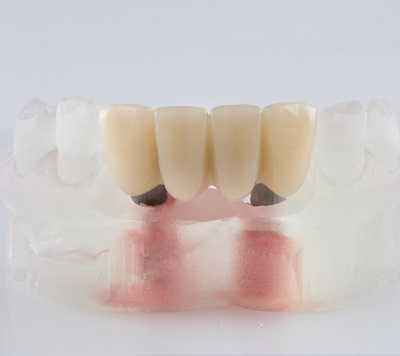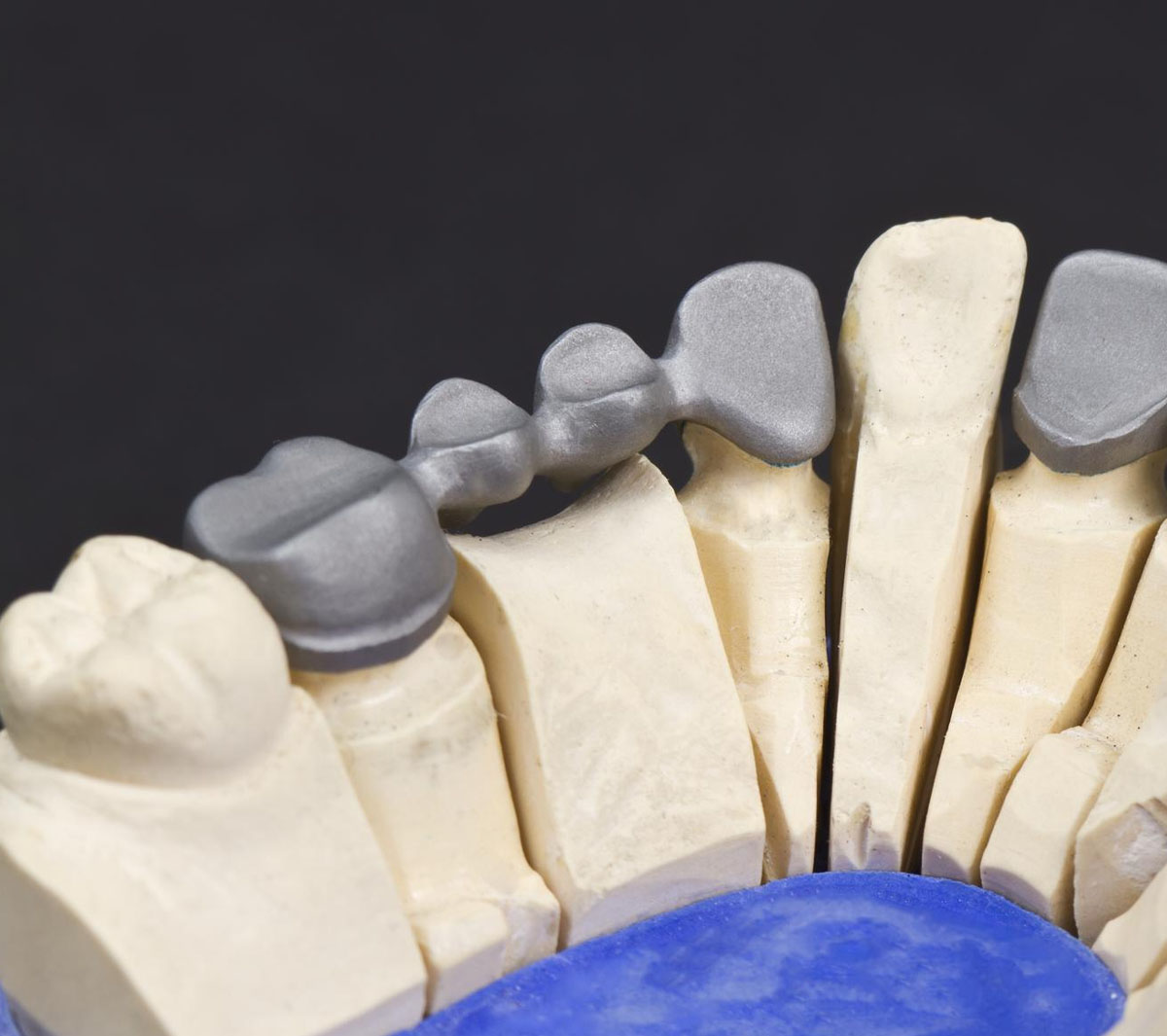We understand how missing teeth can impact everything from your smile to your bite, speech, and oral health. A dental bridge can provide you with a reliable, lasting solution and help you regain a complete, natural-looking smile. Here, we will tell you all you need to know about this dental treatment. So, if you feel shy to smile because of a missing tooth, this guide is for you.
What is a Dental Bridge?
A dental bridge is a custom-made prosthetic that fills the gap where one or more teeth are missing. Our dentists anchor it to the surrounding natural teeth or dental implants, effectively “bridging” the space and restoring your smile. It gives your teeth a better look and also supports the natural alignment of your teeth. It helps to prevent problems like shifting, bite misalignment, and jaw discomfort over time. It can also make eating and speaking more comfortable.
Dental Bridge Types
Like any other treatment, dental bridges fall into different types. Let’s see the types in detail:
Traditional Bridge
Traditional bridge is the most common type. In this method, the dentist holds one or more false teeth in place by crowns that are attached to the natural teeth. They are usually made of porcelain fused with metal or ceramic. They are strong and give you a natural look.
Cantilever Bridge
Like a traditional bridge, our dentists use a cantilever bridge in case there are adjacent teeth on one side of the missing tooth. In this case, they anchor the pontic to a single abutment tooth. This type of bridge is less common, and we recommend it for the back of your mouth.
Maryland Bridge
Also called a resin-bonded bridge, the Maryland bridge uses a metal or porcelain framework that is attached to the backs of the adjacent teeth. This type is less invasive because it doesn’t need the adjacent teeth to be filed down. They are not as strong as traditional bridges, and we use them to replace missing front teeth.

Implant-Supported Bridge
This type is supported by dental implants instead of natural teeth. Our dentists use this method when more than one tooth is missing, and there are concerns about putting too much pressure on individual implants that are not connected. It is the strongest and most stable system, but it requires two surgeries. One surgery to place the implants into the jawbone, and a second surgery to place the bridge.
Dental Bridge Procedure
Here’s the dental procedure, step by step:
- In your first appointment, we focus on abutment teeth which are placed next to the gap. Our dentists reshape these teeth to make room for the bridge and ensure it fits properly.
- If you’re getting an implant-supported bridge, we start by placing implants in your jawbone in the areas with missing teeth. These implants act as anchors for the bridge. And, if you’re not getting an implant-supported bridge, we anchor the bridge by attaching crowns to the natural teeth on either side of the gap rather than using implants.
- After this step, we let the implants heal and bond with the bone before moving to the next phase.
- When the abutment teeth are ready, we take precise molds, or impressions, of your teeth and bite. These impressions help us design a bridge that fits perfectly, both in comfort and appearance.
- While we custom-make your permanent bridge, we place a temporary bridge. This temporary option protects your prepared teeth and gums and keeps the area comfortable until your final bridge is ready.
- On your second visit, we place your permanent bridge and make any small adjustments you need for a snug, comfortable fit. We make sure the bridge aligns well with your bite.
- After confirming the fit, we cement the bridge to the abutment teeth or attach it to the implants.
Can You Put a Dental Bridge After a Crown?
Yes, bridges can use an existing crown on an adjacent tooth. If you already have a crown next to the gap, we can use it to help support the bridge and avoid additional dental work. This is a cost-effective way to replace missing teeth, as we integrate the existing crown into the bridge and create a seamless and stable structure.
Dental Bridge vs. Implant
Choosing a dental bridge or an implant depends on different factors, like your needs, oral health, and budget. A dental bridge is a quicker, less invasive option that relies on surrounding teeth for support. It’s typically more affordable and ideal if you want to avoid surgery. On the other hand, Implant requires surgery to place a titanium post in the jawbone, which serves as a strong, long-lasting anchor for a crown or bridge. Implants stimulate the jawbone, prevent bone loss, and maintain facial structure. You may find that implants feel closer to natural teeth due to their stability.
Our team at Kirkland Dental Excellence will guide you through the pros and cons of each option to find the best solution for your smile. All you need to do is to call us at (425) 827-2003.
Dental Bridge Recovery Time
Recovery after this dental procedure is often quick and smooth. Recovery time based on the bridge type goes as follows:
- When it comes to traditional and cantilever bridges, recovery time takes 3-5 days.
- For Maryland Bridge, recovery may last 2-3 days, and you resume normal activities and eating within 3-5 days.
- Implant-supported bridge recovery lasts around 5-7 days.
You may experience mild discomfort, but this fades after a few days. You may feel some sensitivity to hot or cold foods, which goes away as you adjust to the bridge. To ease any initial soreness, try not to eat very hard or sticky foods and brush and floss gently around the area. Finally, you will resume their regular eating habits within a week.
How Long Does a Dental Bridge Last?
It may last between 10 and 15 years or even longer if you take proper care of it. If you take good care of your bridges:
- Traditional and Cantilever bridges last 10-15 years.
- Maryland bridges last up to 10 years.
- Implant-supported bridges Can last 15 years or more.
To take proper care of your teeth, you should:
- Brush twice daily (use a soft-bristled toothbrush).
- Use special floss for daily flossing.
- Rinse with an antibacterial mouthwash.
- Avoid hard and sticky foods.
- Schedule regular dental checkups.
- Try to use a mouthguard.
- Have a healthy diet to support your oral health.
- Never use your teeth to open packages or bite on non-food items.

Dental Bridge Before and After
Before the Bridge:
- Difficulty chewing certain foods comfortably.
- Challenges with speaking clearly.
- Feeling shy about gaps in your smile.
- Lack of confidence to smile fully or laugh openly.
After the Bridge:
- Easier and more comfortable to chew, even with tough foods.
- Improved speech clarity and confidence in conversations.
- Restored, complete smile that feels natural.
- Boosted self-confidence and freedom to smile.
Note: Searching for before and after dental bridge images can also help you decide if it is a good fit for you.
Dental Bridge Cost
The cost of a dental bridge depends on different factors, including the type of bridge, materials used, the number of teeth being replaced, the dental clinic you choose, and your dentist’s skills. Complex bridges may come at a higher price due to the specialized materials and procedures involved. Our team can give you a detailed cost estimate after discussing your unique needs and the best bridge option for you.
Many insurance plans cover a part of your treatment, often up to 50% of the cost. Understanding your dental bridge cost with insurance can make planning easier and help you get the most out of your coverage. To learn the price and insurance based on your conditions, call us at (425) 827-2003.
Dental Bridges Near Me in Washington
If you’re looking for a reliable dental clinic in Kirkland, Washington, we are here to help. We use top-quality materials and technology to ensure your bridge is durable, comfortable, and looks natural. You can also make an online appointment for a free consultation. Don’t hesitate and schedule your appointment right now.
FAQ
Yes, with good care, it can last many years before needing replacement.
It typically lasts between 10-15 years, depending on how well you care for it.
If your bridge feels loose, you experience discomfort, or you notice any unusual symptoms, contact us. Early intervention can prevent further issues.
Yes, most patients find that a well-fitted bridge feels very much like their natural teeth.
The price without insurance depends on your conditions.
